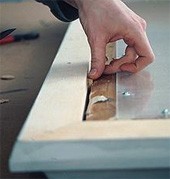Preservation specialists construct housings for prints, drawings, photographs, and books that minimize damage from mishandling, fluctuations in temperature and humidity, pollutants, and pests. These housings include various types of mats, folders, boxes, and sealed packages made from chemically stable materials. By contrast, poor-quality, unstable storage materials and inappropriate matting and framing techniques can cause permanent damage to works on paper. Whether preparing objects for storage or for exhibition, framing specialists evaluate each work of art individually. The work’s size, the characteristics of the image material (powdery or textured), and the paper’s condition (brittle, flat, or distorted) determine the choice of enclosure.
Conservation Division
National Gallery of Art
2000B South Club Drive
Landover, MD 20785
[email protected]
Matting and Framing
Preservation Practices
For prints, drawings, and photographs to be safe for researchers to handle, they are stored in mats or folders made of chemically stable card. Matted works are usually secured to a back mat with hinges of Japanese paper, which is strong and flexible even in its thinnest forms. Part of the Japanese paper strip is adhered to the artwork with a reversible and stable adhesive; the remaining part of the strip is attached to the back mat. Completely non-adhesive ways of affixing the artwork to the mat are also possible. Linen and paper tapes with water-activated adhesive are used to join the parts of the mat. Pressure-sensitive tapes are not applied to works of art on paper.
Matted artworks are then housed in drawers or in sturdy boxes placed on shelves in a climate-controlled storeroom. A lightweight sheet of interleaving tissue is placed between the window mat and the face of each artwork to protect it. Drawings with powdery media, such as pastel, are stored in frames or in custom-made boxes with rigid lids to prevent anything from touching their vulnerable surfaces.
In framing works of art, sheets of filtered acrylic are used to guard against the most damaging, ultraviolet portion of light rays. Works with friable media are framed with static-dispersive acrylic, as well as with customized deep mats, to eliminate any possible contact between the glazing and the fragile surfaces. Framed works are stored upright in slotted bins, on shelves, or hung on rolling screens, depending on the media and condition of the art.
Hinge-Free Mounting
Learn how to mount prints, drawings, or photographs into a mat without applying adhesives or tapes directly to the work of art.
- See Works on Paper
- Visit the Paper Sample Collection

